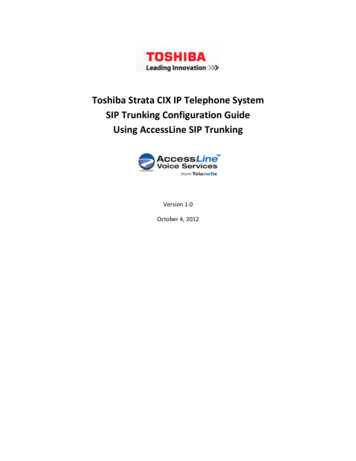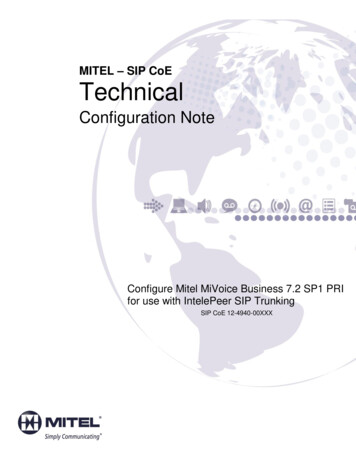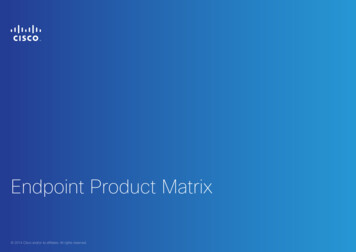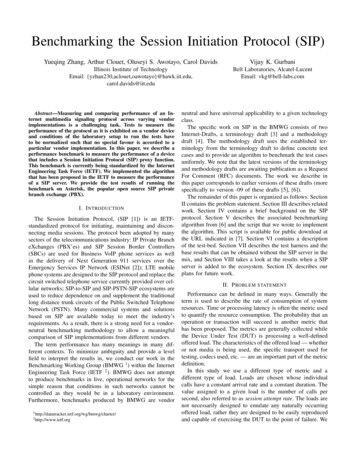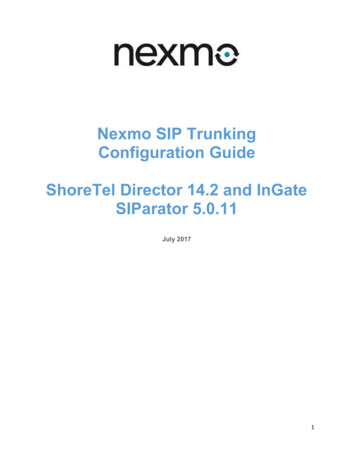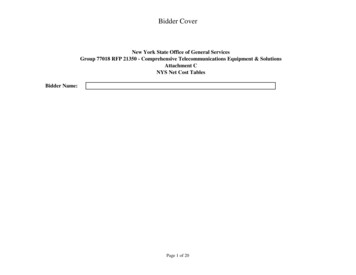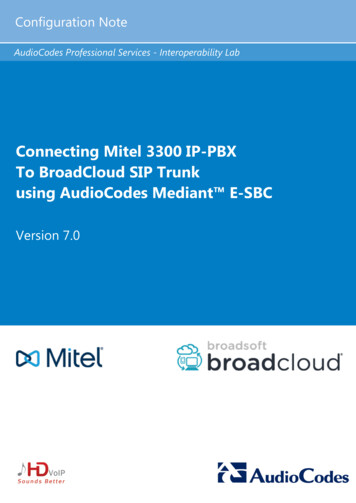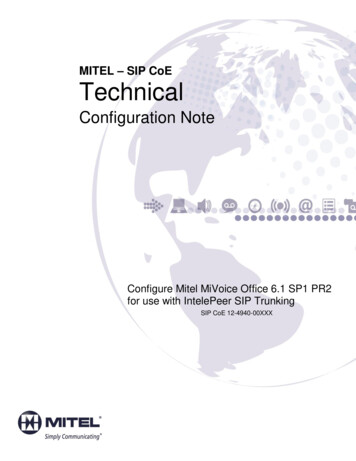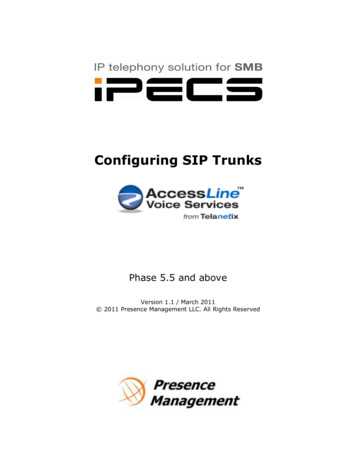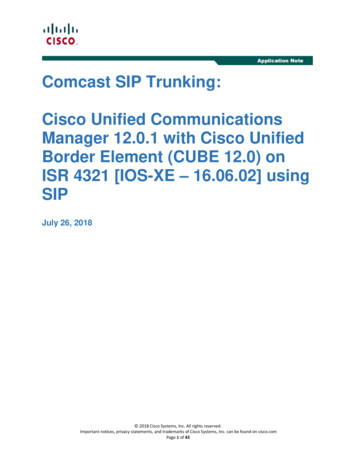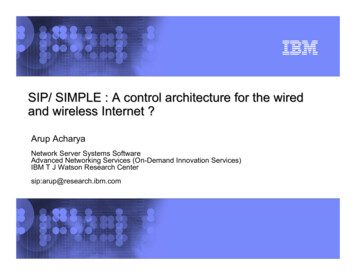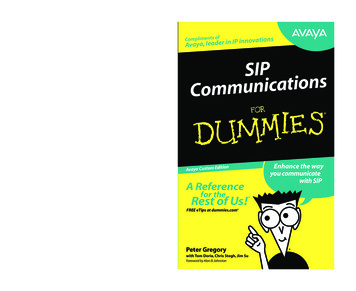
Transcription
Realize your fullcommunications potentialwith SIP!Integrate SIP withexisting systems andsimplify your communications architecture!SIP is transforming instant messaging, voice, and videocommunications, by adding intelligence and reducing cost.The new world standard for facilitating communications,SIP makes it easier to communicate with the right people,at the right time, on the right device. This book showsyou how SIP can be easily integrated into any large orsmall enterprise to lower cost, improve productivity,and simplify communications.Leverage SIP andPresence to streamlinecommunications andeliminate phone tagBetter support yourmobile work forcewith SIP-enabledcommunicationsCompliments ofinnovationsIPinredale,ayaAvSIPsnoitacinuCommTake advantageof SIP for PBX-lesscommunicationsEnhance the wayyou communicatewith SIPitionAvaya Custom Edain EnglishExplanations in pl” formation“Get in, get out invigational aidsIcons and other na@Top ten lists Choose from manyA dash of humorand funA Reference Find listings of all our booksdifferent subject categories Sign up for eTips atfor theRest of Us! FREE eTips at dummies.com etips.dummies.comPeter GregoryISBN: 0-470-04149-8Not resaleablewith Tom Doria, Chris Stegh, Jim SuForeword by Alan B. Johnston
SIPCommunicationsFORDUMmIES‰AVAYA CUSTOM EDITIONby Peter Gregorywith Tom Doria, Chris Stegh, and Jim SuForeword by Alan B. Johnston
SIP Communications For Dummies , Avaya Custom EditionPublished byWiley Publishing, Inc.111 River StreetHoboken, NJ 07030-5774www.wiley.comCopyright 2006 by Wiley Publishing, Inc., Indianapolis, IndianaNo part of this publication may be reproduced, stored in a retrieval system or transmitted in anyform or by any means, electronic, mechanical, photocopying, recording, scanning or otherwise,except as permitted under Sections 107 or 108 of the 1976 United States Copyright Act, without theprior written permission of the Publisher. Requests to the Publisher for permission should beaddressed to the Legal Department, Wiley Publishing, Inc., 10475 Crosspoint Blvd., Indianapolis, IN46256, (317) 572-3447, fax (317) 572-4355, or online at http://www.wiley.com/go/permissions.Trademarks: Wiley, the Wiley Publishing logo, For Dummies, the Dummies Man logo, A Referencefor the Rest of Us!, The Dummies Way, Dummies Daily, The Fun and Easy Way, Dummies.com, andrelated trade dress are trademarks or registered trademarks of John Wiley & Sons, Inc. and/or itsaffiliates in the United States and other countries, and may not be used without written permission.All other trademarks are the property of their respective owners. Wiley Publishing, Inc., is not associated with any product or vendor mentioned in this book.LIMIT OF LIABILITY/DISCLAIMER OF WARRANTY: THE PUBLISHER AND THE AUTHOR MAKENO REPRESENTATIONS OR WARRANTIES WITH RESPECT TO THE ACCURACY OR COMPLETENESS OF THE CONTENTS OF THIS WORK AND SPECIFICALLY DISCLAIM ALL WARRANTIES,INCLUDING WITHOUT LIMITATION WARRANTIES OF FITNESS FOR A PARTICULAR PURPOSE.NO WARRANTY MAY BE CREATED OR EXTENDED BY SALES OR PROMOTIONAL MATERIALS.THE ADVICE AND STRATEGIES CONTAINED HEREIN MAY NOT BE SUITABLE FOR EVERY SITUATION. THIS WORK IS SOLD WITH THE UNDERSTANDING THAT THE PUBLISHER IS NOTENGAGED IN RENDERING LEGAL, ACCOUNTING, OR OTHER PROFESSIONAL SERVICES. IF PROFESSIONAL ASSISTANCE IS REQUIRED, THE SERVICES OF A COMPETENT PROFESSIONALPERSON SHOULD BE SOUGHT. NEITHER THE PUBLISHER NOR THE AUTHOR SHALL BE LIABLEFOR DAMAGES ARISING HEREFROM. THE FACT THAT AN ORGANIZATION OR WEBSITE ISREFERRED TO IN THIS WORK AS A CITATION AND/OR A POTENTIAL SOURCE OF FURTHERINFORMATION DOES NOT MEAN THAT THE AUTHOR OR THE PUBLISHER ENDORSES THEINFORMATION THE ORGANIZATION OR WEBSITE MAY PROVIDE OR RECOMMENDATIONS ITMAY MAKE. FURTHER, READERS SHOULD BE AWARE THAT INTERNET WEBSITES LISTED INTHIS WORK MAY HAVE CHANGED OR DISAPPEARED BETWEEN WHEN THIS WORK WAS WRITTEN AND WHEN IT IS READ.For general information on our other products and services, please contact our Customer CareDepartment within the U.S. at 800-762-2974, outside the U.S. at 317-572-3993, or fax 317-572-4002.For technical support, please visit www.wiley.com/techsupport.Wiley also publishes its books in a variety of electronic formats. Some content that appears in printmay not be available in electronic books.ISBN-13: 978-0-470-04149-9ISBN-10: 0-470-04149-8Manufactured in the United States of America10 9 8 7 6 5 4 3 2 11O/QT/QU/QW/IN
Publisher’s AcknowledgmentsWe’re proud of this book; please send us your comments through our online registration form located at www.dummies.com/register/. For details about how to create aFor Dummies book for your company or organization, please contact dummiesrights&licenses@wiley.com.Some of the people who helped bring this book to market include the following:Acquisitions, Editorial, andMedia DevelopmentProject Editor: Jan WithersBusiness Development Representative:Jackie SmithEditorial Manager: Rev MengleCartoons: Rich Tennant(www.the5thwave.com)Composition ServicesProject Coordinator: Kristie ReesLayout and Graphics:Stephanie D. Jumper, Heather RyanProofreader: Amanda BriggsSpecial Help: Millicent Barksdale,Jennifer Bingham, Lisa Kluberspies,Gabriele McCannPublishing and Editorial for Technology DummiesRichard Swadley, Vice President and Executive Group PublisherAndy Cummings, Vice President and PublisherMary Bednarek, Executive Acquisitions DirectorMary C. Corder, Editorial DirectorPublishing for Consumer DummiesDiane Graves Steele, Vice President and PublisherJoyce Pepple, Acquisitions DirectorComposition ServicesGerry Fahey, Vice President of Production ServicesDebbie Stailey, Director of Composition Services
Contents at a GlanceForeword .vIntroduction .1Part 1: The Case for SIP.5Part 2: SIP at a Glance.13Part 3: How SIP Transforms UserCommunications .23Part 4: How SIP Transforms EnterpriseCommunications .33Part 5: SIP Interoperability.43Part 6: SIP and Server-Free Communications .49Part 7: SIP and the Futureof Intelligent Communications .55Part 8: Top Ten Reasons for SIP-EnhancedCommunications .61
ForewordThese days, in communications circles, Session InitiationProtocol, or SIP for short, is seemingly everywhere.SIP is supported by practically every manufacturer of IP Phone,Gateway, Call Manager, and IP PBX. It is part of the IP MultimediaSubsystem (IMS). It is powering the fastest growing VoIP residential and enterprise providers. It is a part of PC operatingsystems and has been enthusiastically adopted by the opensource movement.Years ago, someone proposed a usage of SIP that was dubbed“SIP for Light Bulbs”! Don’t laugh, it may happen yet.So what is SIP and why is the industry buzzing about it?This book will tell you. What can you use SIP for? This bookwill tell you that too. Why is SIP so important? You’ll find thathere, too.Before I leave you in the competent hands of the authors, Iwill add a few of my own answers here. SIP can be called a“rendezvous” protocol. That is, it allows endpoints on theInternet to discover, locate, negotiate, and establish sessions.What kind of sessions? Any kind of sessions. SIP is used toestablish VoIP (of course), video, gaming, text, call control,and others I’m sure I’ve left out. Recent extensions to SIP addin instant messaging and presence capability. What is presence? This book will tell you, but presence stands ready torevolutionize enterprise communications the same waypublic Instant Messenger networks have revolutionized consumer communications.Besides all these applications and uses, SIP is also generatingits own ecosystem. In the same way that the Internet openedup networking by displacing closed, proprietary networkingprotocols, SIP has opened up communications and displacedclosed and proprietary signaling protocols. It has created anentire ecosystem of interoperable and configurable devicesand services that is revolutionizing the way communicationsis done.
Not bad for a little protocol developed in academia back inthe mid-1990s by such thinkers as Henning Schulzrinne andJonathan Rosenberg.The authors have done an excellent job of explaining the what,why, and how of SIP in an understandable way. Enjoy your readof SIP Communications For Dummies, Avaya Custom Edition!Alan B. JohnstonFebruary 2006
IntroductionImagine a communications environment where a centraldirectory server not only knows how to reach an individual’s work phone, cell phone, and pager, but also her instantmessaging (IM) program, e-mail, and PDA. Not only that, butalso imagine that the central directory server also knows aparty’s communication preferences and capabilities, and canintelligently alert a called party when someone is trying toreach her. Finally, imagine that phone calls to an unavailableperson can be intelligently rerouted to another person orgroup depending upon a number of interrelated factors suchas time of day, whether the called person is scheduled to bein a meeting, or whether one or more of her modes of communication is unreachable.These capabilities aren’t some dream of a far-off utopianfuture, but are available today thanks to a remarkableadvance in communications: Session Initiation Protocol (SIP).SIP is the glue — and the intelligence — that makes theseadvanced communications capabilities possible.Vendors are rushing to incorporate SIP into their products,including those that work with Voice over Internet Protocol(VoIP). Here’s a short list of the kinds of products you canexpect to become SIP-enabled: VoIP phones, gateways, proxies, and servers VoIP softphones — phone software programs that run onPCs, PDAs, and other devices VoIP PBXs Instant messaging (IM) programs Videoconferencing systemsSIP is an open standard, with an active working group on theInternet Engineering Task Force (IETF) that has given SIPtremendous legitimacy and momentum. Avaya and othermajor companies are active in the IETF SIP working group, as
2SIP Communications For Dummies, Avaya Custom Editionwell as in other industry groups working to make sure thatSIP works across enterprises that have a variety of architectures, standards, and products in use.About This BookThis book describes SIP from both business and technicalperspectives. You can read about SIP architecture and operations, as well as its impact on business. You can discoverhow SIP can improve internal and external communicationsas well as the basics of how SIP technology works, and howto build a SIP environment.Foolish AssumptionsWe assume that you have a keen interest in ensuring that yourcompany’s networking and telecommunications systems areup to the challenges of intelligent communications today andtomorrow. Regardless of your role in your organization, thisbook can help you quickly get up to speed on how SIP promises to revolutionize electronic communications.How This Book Is OrganizedEach part of this book considers a different aspect of SIP environments. You may want to read the book cover to cover togain a fuller understanding of SIP, or you may prefer to skiparound to find out what you need when you need it.Part I: The Case for SIP gives you the high-level view of whatSIP is and what it can do for your company’s communications. If you’re unfamiliar with SIP’s benefits, this is a greatplace to begin.Part II: SIP at a Glance explains how being based in currentstandards makes SIP compatible with existing systems. It alsointroduces presence, the SIP feature that adds intelligence tocommunications at many levels, and it describes the components in a SIP network that make intelligent communicationspossible.
IntroductionPart III: How SIP Transforms User Communicationsdescribes how SIP “addressing” works with the concept ofpresence to make reaching users easier, regardless of whichdevice they’re using or where they are.Part IV: How SIP Transforms Enterprise Communicationsexplains how SIP drives down the cost and complexity ofintra-enterprise and inter-enterprise communications bypermitting their consolidation with IP data communications.This part delves into the details of basic SIP calls, includingproxy-mediated voice calls, presence-enabled calls, instantmessaging, and videoconferencing. Here we explain the concept of trunking — that is, connecting enterprises’ IP-basedcommunications systems together over long distances. Wealso discuss ENUM, the protocol that bridges the new SIPbased URI system with the old TDM phone number system.Part V: SIP Interoperability discusses the principles neededto support an enterprise migration to SIP. No two enterprisesare alike, so it would be difficult to come up with a singleworks-for-all recipe for migrating to SIP. Instead, this partexplains what vendors are doing to make multi-vendor integration with SIP as straightforward as possible.Part VI: SIP and Server-Free Communications discusseshow small businesses and distributed offices can take advantage of SIP features, even without dedicated servers.Part VII: SIP and the Future of Intelligent Communicationslooks into the future of SIP and how it will continue to evolveand improve, embracing more communication technologiesand supporting more enhanced communications capabilities.Part VIII: Top Ten Reasons for SIP-EnhancedCommunications offers a condensed list of the most important reasons to put your communications on steroids. SIP willmake your communications more intelligent than anythingelse available today. This intelligence pays off in more effective communications that result in happier customers andmore productive employees. If you’re still sitting on the fenceabout SIP, start here.3
4SIP Communications For Dummies, Avaya Custom EditionIcons Used in This BookThroughout this book, I occasionally use icons to call attention to material worth noting in a special way. Here is a list ofthe icons along with a description of each:Some points bear repeating, and others bear remembering.When you see this icon, take special note of what you’reabout to read.This icon indicates technical information that is probablymost interesting to IT professionals.If you see a tip icon, perk up — you’re about to find out howto save some aggravation.Where to Go from HereNo matter where you are in your SIP project, always keepyour eye on the big picture. Avaya has keen vision and leadership in the communications industry. You can learn a lotfrom this book, but a lot more from Avaya professionals. Turnthe page and discover for yourself why Avaya is one of theleaders in converged voice and data environments poweredby SIP.
Part 1The Case for SIPIn This Part䊳 Defining SIP䊳 Connecting people anywhere, anytime, on any device䊳 Facilitating interoperability䊳 Streamlining communications with or without servers䊳 Preparing for the future of SIPDo you increasingly feel like your communication devicesare holding you hostage? Just as you finish checkingyour multiple voice mailboxes you get an instant messagefrom someone that you just left a message for, saying, “I’m offthe phone now, can you call me back?” Or have you left agreeting on your work voice mail saying, “If you’ve missedme, you can call me on my cell phone, or better yet, send mean e-mail if this is after hours.” You may be rapidly reachingthe conclusion that everyone has too many devices, toomany numbers, and too little time. Sometimes modern communications technology seems to have forgotten the mainreason for using it: to communicate with another personmore conveniently.People have more options available to them today for communicating with each other than ever, yet they often have aharder time getting through. The selection of choices spansa dizzying array of technologies and devices that can delivervoice, e-mail, instant messages, and even video. Simply pickingup the phone still works, but now users have more choicesfor deciding how to reach somebody — and, ironically, that isthe problem.
6SIP Communications For Dummies, Avaya Custom EditionWith people more widely available and more connected thanever before, an unintended and unexpected communicationsparadox has emerged. Users need to manage multiple identities for each of the devices and networks that they want touse. Determining the best way to reach a person and managinga contact list for these multiple identities can be staggering.Simply put, communications today has become device-centric, not user-centric.This part outlines how SIP is one innovative technology thatactually helps improve communications without complicating these issues.What Is SIP?Session Initiation Protocol (SIP, pronounced just like sip, as insipping from a fire hose on a hot day) is an open signalingprotocol for establishing any kind of real-time communicationsession. The communication session can involve voice, video,or instant messaging, and can take place on one of manydevices that people use for communicating: laptop computer,PDA, cell phone, IM client, IP phone, and so on. SIP has beendeveloped in the Internet Engineering Task Force (IETF) bycommon participation from various vendors, including Avaya.SIP builds on a number of existing communications protocols. Developers and system administrators can easily workwith SIP, customize it, and program with it. It is rapidlybecoming a standard for service integration (how new services and applications are created and combined) within avariety of wireless and carrier networks, and is gainingmomentum within enterprises. This growing acceptance inboth enterprise and service provider networks offers thepromise of a single unifying protocol that will transform notonly communications within an enterprise, but communications between the enterprise and its ecosystem of partners,suppliers, and customers. Is SIP a refreshing solution to simplifying communications? For companies who need to sortout and reconnect the current tangle of disparate communications protocols and programs: Yes!To understand the power behind this protocol, you need toexamine some of the key factors that are driving SIP’s momentum across all aspects of enterprise communications.
Part 1: The Case for SIPA brief history of SIPSIP traces its origins to the mid 1990sin the Internet’s experimental multicastbackbone, or “Mbone.” This networkwas used to facilitate the distribution ofstreaming multimedia content including seminars, broadcasts of spaceshuttle launches, and IETF meetings.The original draft of the SIP specification was published in the IETF in 1996,and eventually standardized in 1999.Today, the most up-to-date core SIPspecification can be found in RFC(Request for Comment) 3261.Presenting Presence ServicesSIP introduces a new model for communications through itssupport of presence. Presence enables you to locate a userand determine his willingness and ability to participate in asession, even before you initiate communications. This information, reflected across multiple devices such as IP phones,cell phones, and instant messaging clients, makes communication simple and efficient by helping you to reach the rightperson at the right time, on the right device.Presence and preference features enabled by SIP are discussed in more detail in Part 3.Celebrating User-CentricCommunicationsCommunications today are device-centric. Every device hasits own phone number, address, or alias. The more devicesyou use, the more addresses others need to remember inorder to reach you. And without presence, as described inthe previous section, communication becomes a guessinggame when trying to connect with people, wherever theymay be and whatever they’re doing.7
8SIP Communications For Dummies, Avaya Custom EditionDo we need fold-out business cards?You probably don’t consider yourself acommunications geek, but like mostmodern business people, you probably have many ways to communicatewith others. For example, a typicalsalesperson may have: Three phone numbers (home,work, cell) Text messaging and e-mail ona PDA IM identities on Yahoo!, Google,MSN, and AOL IM capabilities on a laptop and ona cell phone Four e-mail addressesAll of these identities operate insilos — none is aware of any other.The salesperson’s communicationscapabilities have not become easier,but more difficult, because of the lackof integration between all of thesemedia types. SIP promises to bring allof these capabilities (and more) backtogether.With SIP, communications become user-centric once again.A SIP address of record (AOR) provides one unifying identifierthat can be mapped across multiple devices and media types.You can think of an AOR as the user’s “public address.” Part 2explains more about AORs.Simply put, SIP-based communications are between people,connected together without needing to know which devicethey happen to be using. No more tracking of multiple phonenumbers, e-mail addresses, and IM contact names.SIP is particularly suited to facilitating communicationswith mobile devices such as laptop computers, cell phones,and PDAs. Part 3 describes how SIP enables mobilecommunications.Nevertheless, SIP still supports the legacy public switchedtelephone network (PSTN) with its numeric dialing becauseit’s going to be around for quite a long time. An effort to mapPSTN telephone numbers with SIP’s newer user-centric identifiers is discussed in Part 4.
Part 1: The Case for SIPEncouraging InteroperabilitySIP uses a text-based language. That doesn’t mean that SIPsupports only text; it means that SIP’s messages are easy toprogram and interpret, making it easier to achieve interoperability between different vendor implementations. SIP is alsovery modular and extensible, allowing for the integration ofexisting legacy protocols. These properties make SIP an idealprotocol for implementing a standards-based converged communications network.The SIP standard is defined in RFC 3261 by the InternetEngineering Task Force (IETF). The IETF is a large openinternational community of network designers, operators,vendors, and researchers concerned with the evolution ofthe Internet architecture and its operation. Several neutralconsortiums, including SIPit, SIP Foundry, and SIP Forum,arrange meetings and events where companies with SIP-basedhardware and software products can test interoperability withother SIP-based products. This testing helps to promotesmoother integration of SIP-based products in carrier andenterprise networks. We tackle this subject in depth in Part 5.Some vendors have gone beyond these efforts with activeSIP interoperability and ecosystem programs. In a well-run SIPecosystem, devices and services obviously need to worktogether seamlessly, and the only way to ensure that they dois for many kinds of vendors to test their SIP-based productstogether. For example, Avaya has made a commitment toestablishing openness and interoperability for SIP through itsDeveloper Connection program, which support softwaredevelopers, systems integrators, and service providers intesting interoperability and developing SIP-based solutionswith Avaya products and services. You can find more information about interoperability efforts in Part 5.The impact of SIP goes beyond internal communicationswithin an enterprise. SIP has become a signaling standard forcarrier networks. Service providers have started to provideSIP-based trunk services that can reduce costs and extendan enterprise’s SIP environment into the public network.The adoption of SIP for external connectivity will lead to a9
10SIP Communications For Dummies, Avaya Custom Editiontransformation in communications between an enterpriseand its ecosystem of partners, suppliers, and customers.SIP may eventually become the unifying protocol for all communications. You can find more information about SIP trunks,connectivity to PSTN networks, and connecting enterprise“islands” in Part 4.Simplifying CommunicationsArchitectureCommunications networks today are complex and costly tooperate. When you begin investigating ways to transition toSIP telephony, you may feel rather bewildered by the arrayof protocols, gateways, security constraints, and quality ofservice issues. A considerable effort is required to plan,build, and operate these multiple media streams that oftencoexist on shared physical networks. Rush-hour traffic gridlock, by comparison, is an easy problem to solve.SIP offers the promise of a single unifying protocol for allcommunications. With SIP being widely deployed in bothservice provider and enterprise networks, the need for gateways that translate one protocol to another (for example,IP to Time Division Multiplexing, or TDM) is eliminated.Proprietary signaling protocols give way to a single standardinterface for all connectivity, whether for adding endpoints,deploying contact center adjunct services, or even connecting to trunk services for external communications. See Part 4for more details on trunking with SIP.An equally important foundation of SIP is the concept ofdistributed intelligence. This concept, evident in exciting newpeer-to-peer (P2P) architectures such as Avaya one-X QuickEdition, creates a new paradigm in communications, requiring no PBX or communication server, only intelligent phonesand other endpoint devices as the mechanism for establishing a working communications system. We discuss QuickEdition in more detail in Part 6.SIP scales well for the smallest businesses, where SIP-enabledendpoints can be established in the absence of centralizedproxies and registrars. We discuss how SIP can power smalloffices in Part 6.
Part 1: The Case for SIP11Building a Foundation forStandardized, IntelligentCommunicationsSIP, defined in IETF standards, is a structured, text-based protocol that is modeled after HTTP, or HyperText TransportProtocol, the language that powers the World Wide Web.Because SIP is text-based and similar to HTTP, applicationdevelopers and system engineers will have an easier timedeveloping and integrating applications with communications systems.SIP’s architecture consists primarily of SIP endpoints andSIP servers. Endpoints are also called user agents — the programs and devices that actually perform the communicationsbetween end-users. In small organizations, the user agentscan be smart enough to communicate to one another withoutthe need for servers. In large enterprises, centralized SIPservers such as proxies, registrars, and presence servers,facilitate user agent communications. SIP components, andeven an example call scenario, are found in Part 2.SIMPLE (SIP for Instant Messaging and Presence LeveragingExtensions) is an important standard that facilitates instantmessaging communication. SIMPLE is essentially a standardization of SIP’s presence features. We describe SIMPLE in moredetail in Part 2.Where Will SIP TakeCommunicationsin the Future?SIP, extensible and versatile as it is, continues to grow andevolve. In the near future, you’ll likely see SIP become integrated into business applications with several types offunctionality — far beyond simple click-to-call hyperlinks.Applications will be able to make communications routingand other decisions based upon interaction with users.
12SIP Communications For Dummies, Avaya Custom EditionWe’re predicting that the multiple addresses associated withvarious modes of communication (IM, text messaging, e-mail,phone) will collapse into a single SIP user id. This single userid, coupled with SIP presence servers, will put communications (with the right people and in the right medium) at yourfingertips, no matter what kind of communications deviceyou or they are currently connected to.SIP may also follow the lead of E911 emergency location services in cellular networks by using a user’s known physicallocation to make even better decisions about the initiation ofcommunication sessions.We don’t want to give away all of our predictions here. Turnto Part 7 for more prognostications about SIP.
Part 2SIP at a GlanceIn This Part䊳 Working with existing protocols䊳 Extending SIP to multimedia sessions䊳 Getting to know SIP presence䊳 Examining SIP components䊳 Following an example of basic operationsSIP is an application layer Internet protocol for establishing,manipulating, and tearing down communication sessions. You can do a lot more with SIP than set up telephonecalls. The protocol is designed to be extensible — meaningSIP can be easily extended to accommodate video, instantmessaging (IM), and yet-to-be-invented communicationsmedia and features. (XML is an example of another extensiblelanguage.) Aside from supporting communication call setupand tear down, SIP also currently supports extensions forinstant messaging as well as advertising and tracking useravailability (both familiar today in Yahoo! and AOL InstantMessenger).SIP is used to identify, locate, and enjoin parties who wish tocommunicate using any peer-to-peer media type. However,SIP does not transport the media itself: that is handled bycodecs within the communications programs or devices.
14SIP Communications For Dummies, Avaya Custom EditionBased on Existing InternetStandardsAlthough SIP may seem new, it’s actually based on manyprotocols that are widely used today across the Internetand in many enterprise applications. The IETF communitytook Internet standards as a model, and used a text-basedrequest/response model at the heart of the SIP protocol.If you use Web browsers (and who doesn’t?), then youalready depend on a protocol very similar to SIP, called HTTP(HyperText Transport Protocol) — yep, that bit before a standard Web address that you usually take for granted. SIP ismodeled after HTTP, and in fact uses much of HTTP’s syntaxand semantics. Both are text-enco
etips.dummies.com Integrate SIP with existing systems and . It is powering the fastest growing VoIP resi-dential and enterprise providers. It is a part of PC operating systems and has been enthusiastically adopted by the open source movement. Y
